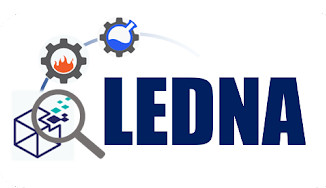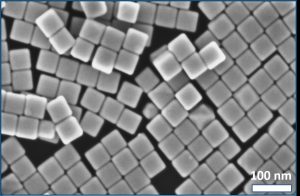Participants:
Jérôme Caron (M2, 2013) ; Mohammad Khaywah (Post-doc, 2016) ; Laurent Xu (M2, 2019), Benoit Leduc (M2 + CDD engineer , 2021) ; Maxime GAYRARD (Post-doc, 2025),
Guillaume Le Chevallier, Pierre Lonchambon, Vincent Mertens, Dominique Porterat, Charles Rivron,
Publications: Google Scholar
Summary: The excitation of the plasmon resonance of a metal nanoparticle (NP) generates very intense electromagnetic fields that are confined to the surface of the NP. These fields can be used either to exalt or to initiate a photochemical reaction in the broadest sense, in a “chromophore” placed close to the NP. To this end, since 2008, we have been developing expertise in the colloidal synthesis and self-assembly of high-quality gold nanoparticles. Uniform, crystalline and not rough, these gold nanoparticles have original morphologies (cube, triangle, star, disk, hexagon, etc.) and are available in a wide range of sizes (10nm-1µm). Most of these NPs feature sharp tips to amplify exaltation effects. Gold colloids produce exaltation effects different from those observed with gold nanostructures fabricated by nanolithography. Since 2008, in collaboration with a large number of experts, we have studied several gold nanohybrids consisting of a gold nanoparticle and another component that was either a molecule (such as water or dioxygen for the generation of reactive oxygen species ROS* or a monomer for photopolymerisation. The other component could also be a fluorophore (or Qdot) for light emission, or a semiconductor (e.g. TiO2) or a catalytic NP (Pd, Pt, etc.) for photocatalysis. See also wo Research Groups (GdR) of CNRS working on similar themes: GdR Or-nano and GdR Plasmonique Active
*R.O.S. such as 1O2, OH., O2.-, H2O2

…For Plasmonics
Plasmonics is a discipline of nanophotonics at the interface between physics, chemistry and biology. We began to receive financial support in 2013, via the ANR HAPPLE project (Renaud Bachelot) and then for the COSSMET project (Eric Le Moal) –for details see list below-. We are currently pursuing our studies in the field of plasmonics thanks to three ongoing ANR projects. ULTRASINGLE (Aurélien Crut, ILM) which uses optical and numerical methods to study the influence of nanoparticle characteristics (size, morphology, functionalization) and their local environment (composition and thickness of the substrates used for deposition) on ultrafast energy exchange in individual nano-objects. CARICATURES (Sébastien Bidault, Institut Langevin) dedicated to the study of strong coupling within DNA nanohybrids (origami). The aim of POPCORN (Céline Fiorini, CEA) is to obtain a better understanding of the fundamental mechanisms at the origin of the production of light, heat and electron-hole pairs in gold nanohybrids. Using an original nano-photopolymerisation technique developed jointly by the Mulhouse (O. Soppera, IS2M) and Troyes (R. Bachelot, L2N) teams, the POPCORN consortium has succeeded in depositing polymers with specific properties in thin layers (~ 1 nm) one after the other, and in positioning quantum emitters at very precise sites with nanometric precision. Several light emission regimes, controlled by a simple rotation of the direction of the incident polarization, have thus been characterized and modelled. The trapping of single nano-emitters has made it possible to demonstrate the very first all-optical single-photon switch actuated via the direction of polarization. In the fabrication of these gold nanohybrides, the precise positioning of the active medium, on a nanometric scale, is always a challenge. Here, our team provides a sought-after expertise, thanks to the possibility to:
1- adapt the plasmon resonance of the gold nanoparticle to the irradiation wavelength of the NP in a very broad spectral range and proposing a large morphology range.
2– propose sharp and anisotropic nanoparticles (cubes, triangles, etc.) or on the contrary, isotropic and rounded shapes (spheres, discs).
3- manage the interface between the gold NP with its environment (roughness and cleaning of the gold surface, exchange of surfactant/solvent, silica coating..).
… for Health
In the field of phototherapy, the generation of plasmon-induced heat and more recently the generation of R.O.S. from gold NPs alone (i.e. without the addition of a porphyrin-type photosensitizer) is an original approach to treating tumours, especially when the tumour is low in oxygen, making conventional PDT non-functional. The HEPPROS project (2018-2021; coord. B. Palpant, CentraleSupelec, Paris-Saclay) aimed to study the generation of heat and R.O.S. for various gold NP morphologies in order to better understand the complex transient mechanisms involved at the gold NP/ adsorbate interface, under the action of ultrashort pulsed light (few femtoseconds). This project has enabled us to show that a thin layer of dense silica around gold nanorods inhibits all possible ROS production pathways, making them functional for all kinds of biomedical applications.
Since 2008, we have been developing a great number of protocols for exchanging the cytotoxic CTAB surfactant around these gold NPs and for dispersing and assembling the NPs on various substrates. In particular, the gold NPs can be coated with a layer of silica whose thickness and porosity can be adjusted at will, using sol-gel chemistry. These so-called Au@silica core-shell nanoparticles have great potential as contrast agents for numerous medical imaging techniques (photoacoustics, dark field scattering, multi-photon luminescence, high-frequency ultrasound, quantitative phase contrast, computer tomography, etc.).
What’s next?
Gold NPs are excellent sensors of the LSPR, SERS, Fluorescence, Pressure and Colorimetric type (pregnancy and COVID tests). The next focus of our activities is the development of plasmonic sensors based on two-dimensional (2D) assemblies of gold nanoparticles for the detection of pollutants and biomarkers. We are seeking to develop know-how for self-assembly of these NPs into compact two-dimensional (2D) arrays to produce ultrasensitive, low-cost nanodevices for screening, early diagnosis of diseases and detection of pollutants. Depending on the application, the gold nanoparticles may be bare or covered with an organic monolayer or a layer of silica. When the inter-particle distances are very small, the numerous electromagnetic hot spots enable light-matter interaction to be exalted, in particular heat and charge transfer at the gold surface. These nanometric films will be transferred to a variety of substrates for health and environmental applications. These compact 2D assemblies are very promising for SERS (Surface-Enhanced Raman Scattering) and also as chemiresistive gas sensors for detecting volatile organic compounds (VOCs), particularly those present in breath and associated with pathologies. Highly monodisperse gold nanoparticles (in size and shape) should make it possible to improve the reproducibility, sensitivity and selectivity of these sensors, thanks to a regular and homogeneous spatial distribution on a large scale. In the longer term, other applications linked to the environment and energy are envisaged via the synthesis of bimetallic or hybrid NPs of the Au@X type (X= Ag, Pd, Pt or TiO2) organised in two-dimensional networks.
Grants
2021 : ANR POPCORN (from 2022 to feb.2026) with teams , see below: 2 (coordinator), 1,3
Photochemistry and photophysics of plasmons towards fully controlled nanolocalized polymerization
2021 : ANR CARICATURES (from 2022 to sept.2026)with teams: 10 (coord), 11
Chemically addressing high curvatures at the nanoscale to optimize light-matter interactions
2020 : ANR ULTRASINGLE (2021-2024) with teams: 8 (coord), 9
Ultrafast energy transfer in single nanosystems
2018 : Plan Cancer HEPPROS (2018-2021) with teams : 5 (coord), 2, 6, 7
Highly Efficient Plasmonic Production of Reactive Oxygene Species for Photodynamic Therapy
2013 : DIM Nano-K COSSMET (2014-2015): with team 4 (coord)
Contrôle Spectral et Spatial des plasmons de surface Excités par Microscopie à Effet Tunnel
2012 : ANR HAPPLE (2013-2017) with teams 1 (coord), 2, 3
Hybrid Anisotropic Plasmon Photonics for Light Emission
Collaborations
- R. Bachelot, P. M. Adam, J. Plain, UTT Troyes, L2n CNRS-ERL 7004
- L. Douillard , C. Fiorini, S. Vassant, F. Charra, CEA Saclay, SPEC UMR 3680, équipe LEPO
- O. Soppera, C. Molinaro, Molécules, Nano-, Micro-structures, IS2M, Mulhouse,
- E. Le Moal, E. Boer-Duchemin, G. Dujardin, Orsay , ISMO, équipe Nanophys
- B. Palpant, CentraleSupelec, Paris-Saclay, LuMIn
- R. Pansu (ENS Paris-Saclay , anciennement PPSM)
- G. Bousquet, Ch. Leboeuf, UMR_S942, batiment SMBH, Bobigny
- A. Crut, Noelle Lascoux, Natalia Del Fatti et al, Lyon, ILM, équipe FemtoNanoOptics
- M. Treguer Delapierre, Bordeaux, ICMCB
- S. Bidault, Paris ESPCI, Institut Langevin UMR7587
- G. Bellot, Montpellier, CBS
NIMBE Research Axis





